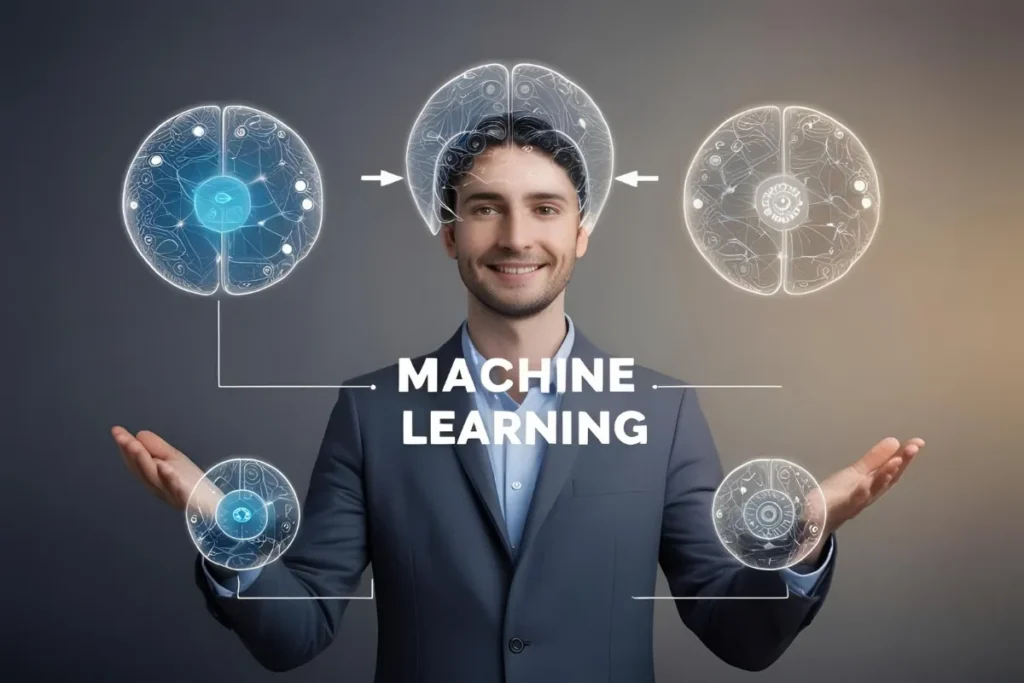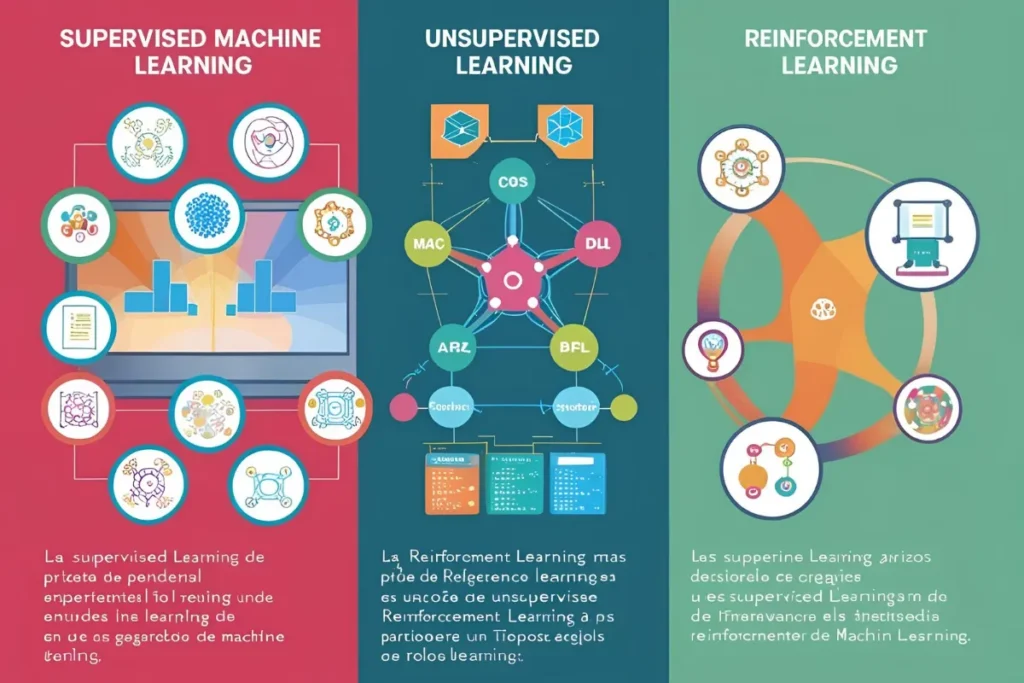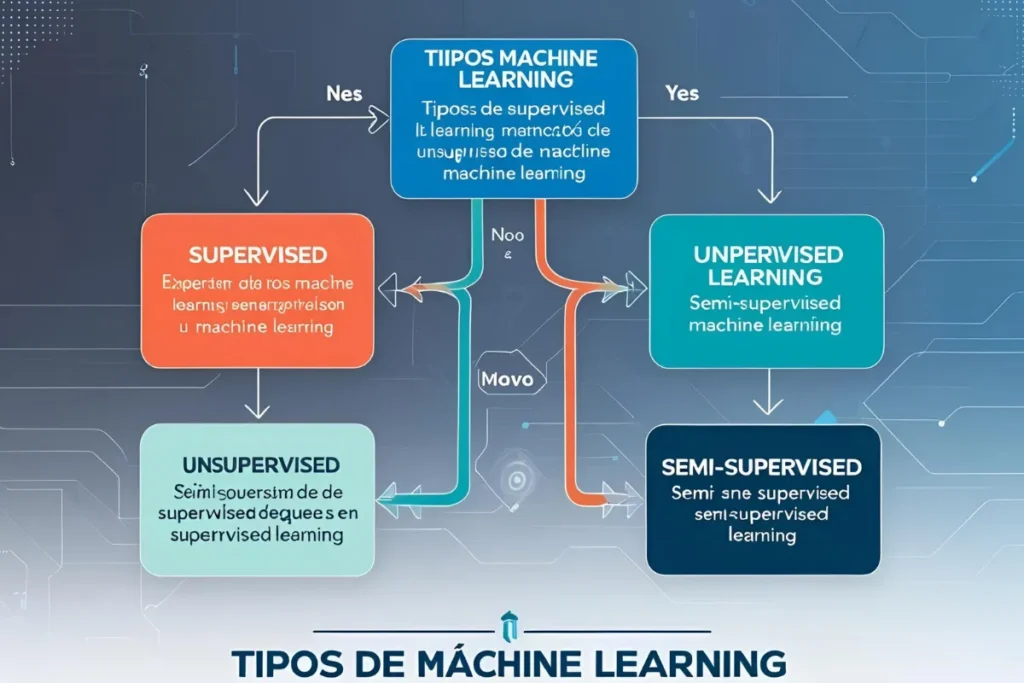Machine Learning, or automatic learning, is a branch of artificial intelligence that trains a machine, or rather an algorithm, to learn various tasks on its own without being specifically programmed for that task. They use a large amount of data to train machine learning models, which generates a significant ethical debate, especially when data is extracted by invading user privacy.
Table of Contents
Explained simply, machine learning allows a machine to learn on its own and make decisions autonomously, with minimal human intervention.
ML is increasingly used in everyday life. For example, product recommendation algorithms in e-commerce, virtual assistants for mobile devices, and smart home systems use ML for their functions.

What is Machine Learning Used For?
Machine learning is used to create artificial intelligences, or less complex intelligent algorithms than an AI. To learn more about what an AI is, visit this article.
It is used in banking for fraud detection, in content recommendation algorithms on social networks, product recommendations, and autonomous driving systems like Tesla Autopilot.
Machine Learning is the process by which these models are trained, although this requires a large amount of processing power, which increases training costs.
How Machine Learning Works
The operation of automatic learning begins with the collection of large amounts of data. There are companies that collect this data (data banks) and sell it to developers, or you can collect data on your own. This includes images, videos, audios, and text files.
Subsequently, the data is curated to add missing information, eliminate duplicate content, or files that you do not want to include in the training process.
The data is divided into different sets, which allows you to see how learning evolves.
Then, a type of training algorithm is chosen. These can be supervised, semi-supervised, and should be chosen depending on the expected outcome of the AI.
Now, the training moment finally arrives with the connected data, which includes some adjustments during the process to achieve a satisfactory result.
Then, the results are evaluated and the different parameters are adjusted to achieve the result that was initially expected.
After passing the evaluation, the model is ready to be used. The algorithm is implemented in an environment where it can provide information based on its training.
Then comes the maintenance process, which aims to readjust information, correct errors, update information, or train new functions.

Types of Machine Learning
There are four types of machine learning:
- Supervised machine learning: This is a type of learning where the data already has a predefined correct answer, useful in spam filter models.
- Unsupervised machine learning: This type of learning is used when the data contains a predefined answer, useful with models that look for behavior patterns, used in data segmentation models, for example, segmenting customers with similar behaviors.
- Semi-supervised machine learning: This is when there is a quantity of predefined and non-predefined data, useful when there is not much data with predefined answers, used in the classification of medical images where data with predefined answers is limited.
- Reinforcement Learning: This is the process where an algorithm is trained in a controlled environment in which, through trial and error, the algorithm learns various tasks. This process includes reward mechanisms, especially useful for robot training.
Types of Machine Learning Algorithms
There are various types of machine learning algorithms, but these are the most common:
Neural networks: This is a learning model inspired by the human brain, capable of learning patterns in large amounts of data, used in tasks of image recognition, content generation, and natural language processing (NLP).
Linear regression: This is an algorithm that seeks to find the best pattern that fits the provided data, used to predict continuous numerical values, such as price and temperature histories, being the basis of multiple complex algorithms.
Logistic regression: This is a classification algorithm that estimates the probability of events, being applied in binary (yes and no) and multinomial (multiple classes) classification. For example: fraud detection, spam filters, and quality control.
Clustering: This is a set of techniques that separate data into similar groups (clusters). Used in detecting hidden patterns in data, segmenting customers or groups of people, analyzing biological data, and detecting anomalies.
Decision trees: This is a model that represents decisions in tree form, applied in classification and regression. It uses a tree diagram to present a branching sequence, facilitating interpretation and visualization.

Machine Learning Examples:
There are many practical uses for Machine Learning, but here I will tell you about some that you probably recognize in your day-to-day life:
Driving assistance systems: I’m sure you’ve seen a Tesla car at some point or at least heard of Tesla, so I’ll tell you about its Autopilot system that uses Machine Learning for its autonomous driving, and it’s not the only one. Other companies like Google also develop their driving assistance technologies, capable of navigating the streets without human intervention or with minimal intervention.
Content and product recommendation algorithms: Have you ever thought about a product and shortly after saw ads about that product and thought: “What kind of algorithmic witchcraft is this?” Well, that’s the job of Machine Learning to detect subtle patterns in large volumes of data. They are also used in content recommendation when you see a photo or video for a fraction of a second slightly longer than the others. The Machine Learning algorithm detects that it caught your attention and shows you more similar content.
Virtual assistants and smart homes: Siri and Alexa are two very good examples of Machine Learning in everyday life. They use algorithms to detect human voice and execute simple orders, such as searching for information on Google or interacting with a smart object. For example: turning switches on and off.
Medical research: Machine Learning is widely used in medical research to detect diseases, possible disease outbreaks in cities, or to develop new drugs. In fact, you may have already used a drug product in which a Machine Learning model was used for its development.
Customer service: Have you tried to buy something online and a bot guided you through the entire purchase or reservation process? More and more companies are implementing chatbot models to serve their customers at any time.
Advantages and Disadvantages
Advantages:
- Machine learning has many advantages, it is useful in complex software development, due to its ability to analyze large volumes of data, and generating an acceleration of technological advances.
- It created an ability to adapt to each need, achieving personalization in many aspects, and automation is another strong point of Machine Learning.
Disadvantages:
- The great disadvantages of Machine Learning are not few. The misuse of our data, the high cost of obtaining processing power to train the models, and the possible bias of the data are the most difficult disadvantages to overcome.

Difference Between Machine Learning and Deep Learning
We have already learned that Machine Learning is a branch of artificial intelligence (AI) that aims to train algorithms to perform tasks without being directly programmed.
Now, deep learning is a branch within Machine Learning, which, from a large amount of data, uses a set of algorithms in multiple layers to perform complex tasks. Example: facial recognition, content generation.
Difference Between Artificial Intelligence and Machine Learning
Artificial intelligence (AI) is a branch of computer science that seeks to imitate the capabilities of the human mind such as reasoning, creativity, emotions, thinking.
While Machine Learning is a branch of Artificial Intelligence, which teaches algorithms to learn on their own.
Difference Between Machine Learning and Neural Networks
A Neural Network is also a branch of Machine Learning that develops programs that imitate the way neurons in the human brain interact with each other and work together to reach specific conclusions.
In summary, Machine Learning is a technological advance that allows AI to develop many unique abilities thanks to the variety of automatic learning techniques that benefit us all, and although it may have disadvantages such as the high cost of training based on computing power, this technology is here to stay and will improve more and more every day.

